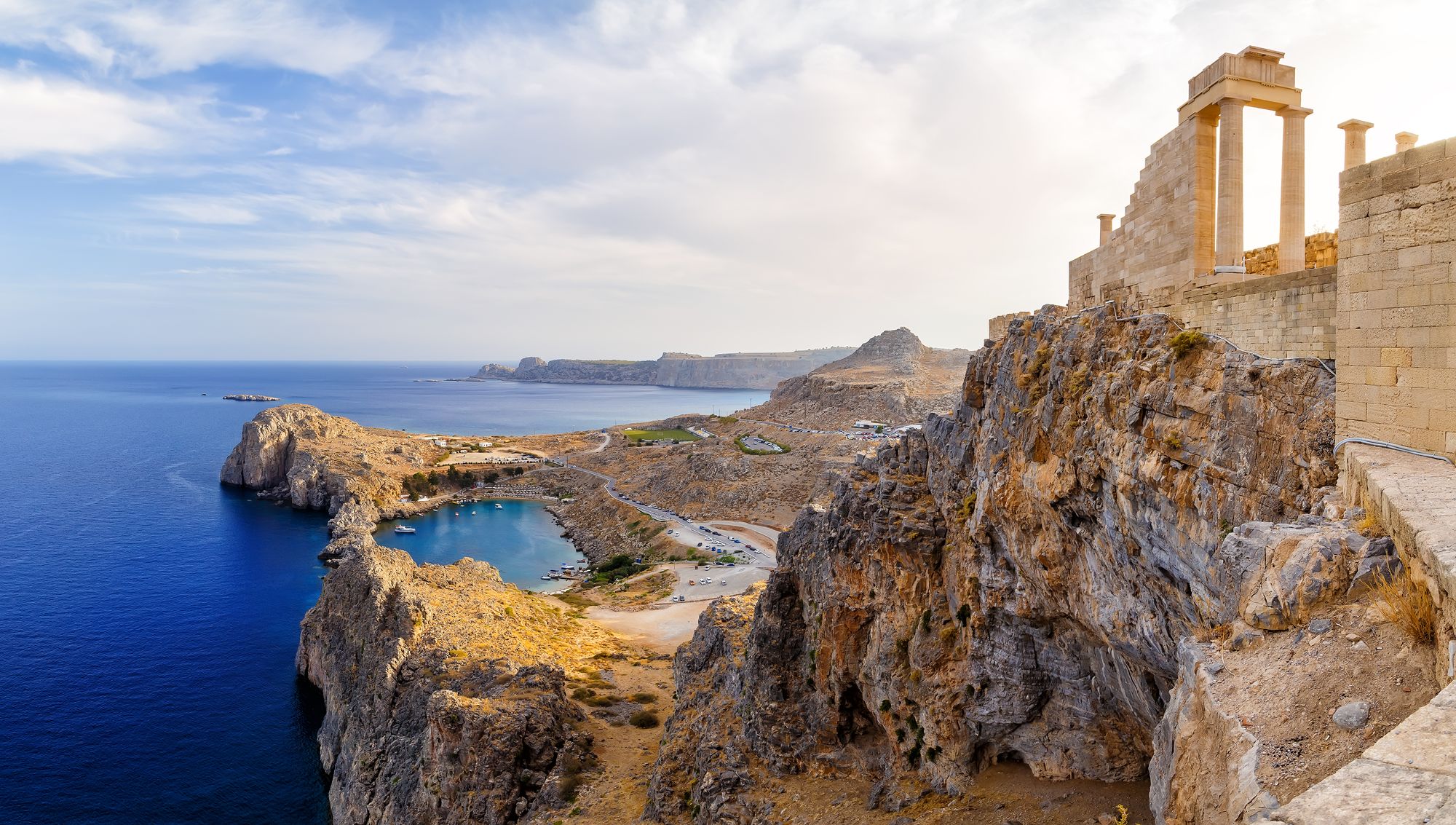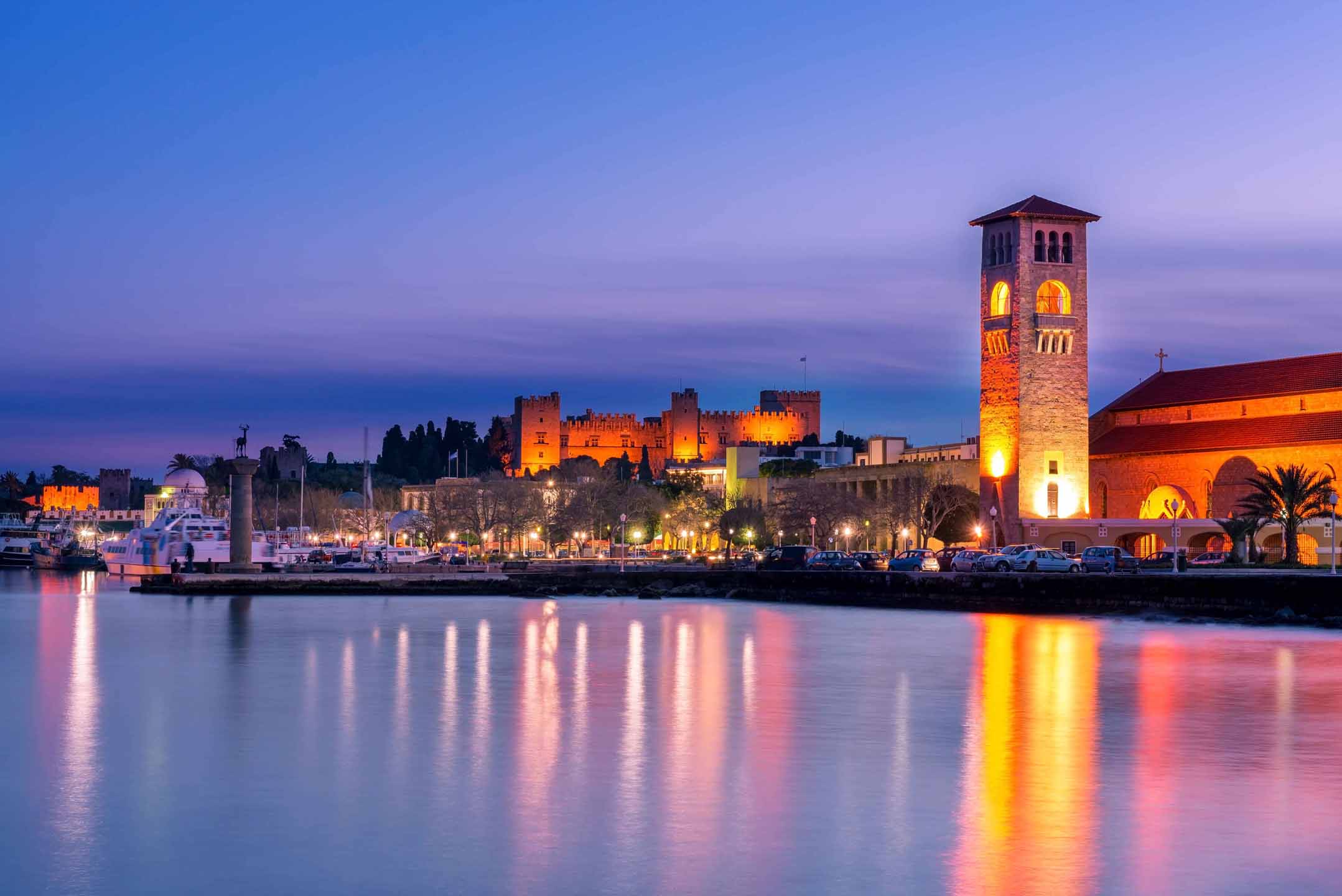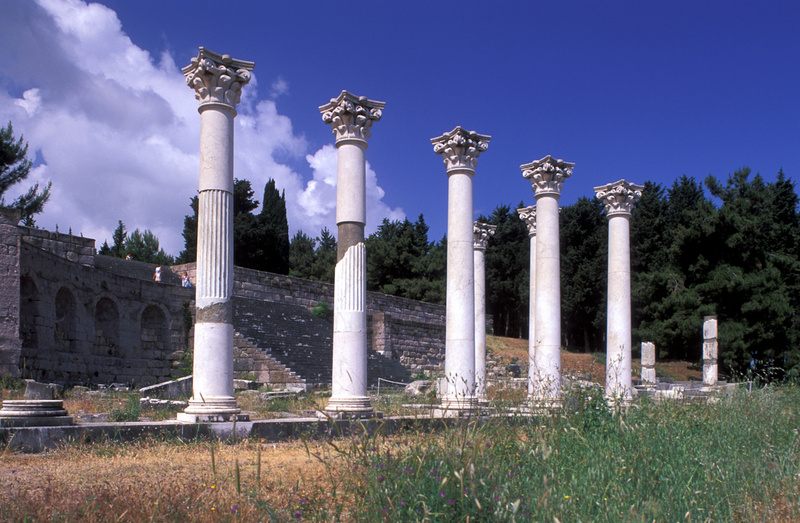



RHODES
Rhodes, the island of the Knights, situated at the crossroads of two major maritime routes, invites you to discover its treasures. A land where historical events and legends intertwine among the medieval walls of the Old Town, wandering its streets transports you into a fairy tale populated by knights and princesses. Be sure to visit the Palace of the Grand Master (Palati tou Megalou Magistrou), and especially Lindos, a true gem of the island with one of the most remarkable archaeological acropolis, perched on a hill offering breathtaking views of the vast blue sea. Nature lovers will be enchanted by the Valley of the Butterflies and the Rodini Park, where swarms of colorful butterflies come to feed on the unique trees of the region. Rhodes is also dotted with picturesque villages such as Ebonas, famous for its vineyards, and Monolithos, where the sunset from its medieval castle atop the hill is simply magical. For wine enthusiasts, don’t miss the opportunity to book a tasting at the local wineries to savor wines like Athiri white and Mandilaria red. Finally, to complete your stay, let yourself be lulled by the tranquility of its beaches: visit Mandraki, the port next to the Old Town, or rent a yacht from Rhodes Marina to explore the island’s coasts and neighboring islands. At Kallithea, the thermal springs will rejuvenate you, while Anthony Quinn Beach, named in honor of the actor who loved its turquoise waters, will transport you to an exotic setting. And of course, Prassonisi, which in summer connects to Rhodes by sandbanks, is a paradise for windsurfing enthusiasts. Access to Rhodes is via ferry from Piraeus with stops at several islands, including from Heraklion in Crete, other Dodecanese islands, and some Cycladic islands. You can also fly from Athens, Thessaloniki, Cyprus, and other international destinations. Don’t miss the chance to savor the authentic olive oil, extracted from local olives, and taste one of the island’s culinary treasures: honey, often considered one of the best in the world. Try the melekouni, a refined local specialty, a blend of honey, crunchy sesame, orange essence, bergamot, and delicate spices. And to top it all off, sip a glass of local sparkling wine while admiring the striking beauty of a Mediterranean sunset.
LEROS
Leros, the island of the goddess Artemis, offers wild beauty and infinite harmony. Its small hills and countless coves, with Lakki being the largest, make this island a paradise for quiet walks and bike rides. Ideal for diving enthusiasts, Leros is home to numerous shipwrecks from World War II. The capital, Platanos, offers stunning views of the Aegean Sea, with windmills creating a perfect backdrop to enjoy a coffee or a glass of wine. The seaside village of Agia Marina, with its neoclassical buildings and bougainvillea-filled courtyards, immerses you in a romantic atmosphere. Its beaches with crystal-clear waters, such as Panteli or Xirokampos, invite relaxation. You can reach Leros by boat from the port of Piraeus or by plane from Athens. The island is also connected by sea to other Dodecanese islands as well as the Cyclades. Leros’ cuisine has a long tradition in sweet treats: be enchanted by the magic of amygdalotá (almond pastries) or try pougákia, delicate small bites filled with bitter almond.










KASTELLORIZO
Kastellorizo, a postcard-perfect island located at the end of Greece, is a true gem for those seeking tranquility. Its name, “Castello Rosso,” refers to the reddish color of the hill where the Knights’ castle stands. The island is perfect for nature lovers, with a network of natural trails leading to chapels scattered throughout. The small port of Kastellorizo welcomes you with its colorful houses, arranged in an amphitheater facing the sea. Time seems to stand still in this idyllic setting. The island’s beaches, mostly rocky, offer crystal-clear waters, with the exception of Mandraki Beach, ideal for those who prefer sandy shores. You can also dive from small rocks into the translucent sea for a unique experience. Don’t miss a visit to the Blue Cave, accessible by boat. It is one of the most impressive caves in the Mediterranean, where sunlight creates a unique sapphire-blue tint in the water. For history enthusiasts, the island’s archaeological museum will transport you through the various periods of Kastellorizo’s occupation, thanks to a collection of fascinating artifacts. You can reach Kastellorizo by taking a boat trip from Athens to Rhodes, where you will then board a ferry to your final destination. A faster option is to fly from Rhodes directly to Kastellorizo. Once there, let yourself be seduced by the island’s culinary treasures. Enjoy the freshest fish you’ve ever tasted, accompanied by local specialties such as delicately prepared stuffed onions, and to end on a sweet note, don’t miss the famous katoumari. This traditional dessert, in the shape of a round tart, is delicately flavored with sugar, cinnamon, and clove, offering a unique and authentic taste experience.
KARPATHOS
Karpathos, an island of striking contrasts, stands out for its imposing mountain range, fragrant pine forests, turquoise coves, and omnipresent history. The island’s capital, Pigadia, is a port city where an imposing rock at the harbor entrance houses the remains of the ancient acropolis. Nearby is Eparheio, an information center on the Mediterranean monk seal, which also features an open-air museum with artifacts from different historical periods of the island. One of Karpathos’s most renowned villages is Olympos. Geographically isolated from the rest of the island, Olympos has preserved its cultural identity, including an ancient dialect dating back to ancient times. The village of Aperi offers spectacular panoramic views of the island and the sea. In the lush region of Volada, stroll through the winding alleys adorned with bougainvillea or hike to the Lastos plateau, dotted with charming chapels and traditional houses. For a swim, don’t miss the beaches of Apella, with its dazzling turquoise waters, Achata, surrounded by tamarisk and rocks, or Agios Nikolaos Beach, with its golden sand, gentle waves, and splendid view of the neighboring island of Kassos. Be sure to taste the local cuisine, including homemade pasta called makarounes, onion bread, and typical cheeses such as manouli and armyrotyri. For dessert, let yourself be tempted by the delicious glyka tou koutaliou made with fruits like quince and grape. You can access Karpathos either by ferry from the port of Piraeus or by plane from Athens. Karpathos is also connected by ferry to other Dodecanese islands, the Cyclades, and Crete.









ASTYPALEA
Astypalaia, a true butterfly floating in the heart of the Aegean Sea, stands out for its unique shape and landscapes steeped in authenticity. Connecting the Cyclades to the Dodecanese islands, it offers a rich historical heritage, rugged coastlines, and picturesque homes with whitewashed facades. The island’s capital, Hora, is perched on a rock plunging into the water, forming two stunning coves. Traditional windmills and a variety of restaurants and cafés can be found here. At the top of Chora, the castle houses iconic churches such as Evangelistria. Livadia, a peaceful coastal village, extends into a large valley bordered by orange groves, vineyards, and flowering courtyards. Maltezana, another tranquil seaside resort, owes its name to Maltese pirates who made Astypalaia their base. Kaminakia Beach is a gem, sheltered from the winds and lined with charming taverns. The island also offers a wide range of idyllic beaches such as Vatses, Plakes, and Panormos. Don’t miss the Dragon Cave, with its impressive stalactites and stalagmites, as well as a caique trip to the islets of Koutsomyti and Syrna. The region’s rich cuisine is a true delight for the taste buds: be sure to savor lampriano, a lamb stuffed with rice and spices, or enjoy kitrinokouloura made with milk, butter, local saffron, and spice for breakfast. Access to Astypalaia is either by ferry from the port of Piraeus or by plane from Athens. The island is also locally connected to other Dodecanese islands.
KALYMNOS
Kalymnos, the island of sponge divers and climbing enthusiasts, is the international center for sponge production and trade, continuing a centuries-old tradition. Its geography also makes it a top destination for climbers, thanks to its ideal rock faces and easy access to climbing sites. For water sports enthusiasts, diving allows exploration of ancient shipwrecks, and hiking trails offer immersion in the island’s landscape. Pothia, the capital built amphitheater-style overlooking the port, combines the architecture of captain’s houses with that of humble sponge diver homes. Visit the archaeological and maritime museums to learn more about sponge fishing. Don’t miss the 15th-century Chrysoheria Castle, with its picturesque windmills. Head to the waterfront street to taste the famous local mezes, including those made with sea urchins and rays, in a small traditional tavern. Discover Vathys, a green oasis full of citrus fruits, and enjoy the splendid sunset at Melitsaha. Finally, the beaches of Emporeios, with its pebbles and crystal-clear waters, and Kastelli Beach, more secluded and accessible by a trail, are worth the visit. Kalymnos is renowned for its rich gastronomy, featuring a variety of delicious dishes. Among the local specialties, you’ll find chtapodokeftedes, octopus meatballs made from freshly caught octopus from the island’s crystal-clear waters. Fish lovers will appreciate the high quality of freshly caught fish, while revithokeftedes, chickpea meatballs, offer a taste of traditional flavors. Don’t miss the mirmizeli, a typical local salad that embodies the authentic flavors of Kalymnos. The island is easily accessible by ferry from the port of Piraeus, providing a direct connection to this culinary and cultural gem.







KOS
Kos, a cosmopolitan island with endless golden beaches and turquoise waters, is the birthplace of Hippocrates, the father of medicine. The island hosts a major archaeological site, the Asclepius Sanctuary, an ancient center of healing and religious significance. Kos is also a haven for numerous peacocks and other birds that find refuge in the Plaka woods. Among the most photogenic beaches on the island, Agios Stefanos stands out with its golden sand and small pebbles, offering breathtaking views of the islet of Katri and the remains of a 4th-century church. Marmari Beach is ideal for activities such as horseback riding, kite surfing, and windsurfing. Zia, one of the most charming and authentic villages, is built in tiers on the rocks, featuring whitewashed houses with blue shutters. Cephalos, the former capital, is a lively village crowned by a medieval castle. Be sure to sample the local olive oil and wine, renowned since antiquity over 4,000 years ago. Before leaving the island, don’t miss tasting glyko ntomataki, local tomatoes preserved in syrup flavored with cinnamon, cloves, vanilla, and other spices. Kos is accessible by ferry from Piraeus or by plane from Athens and other international destinations.
NISYROS
Nisyros, an island of wild beauty and rich history, thrived in antiquity due to its obsidian trade. Mandraki, the charming port capital, enchants with its cobblestone streets and flowering courtyards. Essential stops for history enthusiasts include the Volcanological Museum and the ancient acropolis, with its majestic walls. For relaxation, Pali Beach, with its tamarisk trees and golden sand, is perfect, as is Pachia Ammos Beach, known for its dark sand and shallow, crystal-clear waters.
Nisyros is connected to Piraeus by ferry and also offers local connections to nearby islands. During your visit, be sure to try the revithokeftedes (chickpea fritters), soumada (bitter almond liqueur), and local cheeses, such as tyria, cheese preserved in wine!








PATMOS
Patmos is globally renowned for its religious heritage, being the site where Saint John is said to have received the visions recorded in the Book of Revelation. However, the island also reveals natural treasures: it is a top destination for nature lovers with trails leading to secluded beaches with crystal-clear waters, such as Psili Ammos, a sandy stretch lined with tamarisks. At the top of Hora, the capital, stands the Monastery of Saint John the Evangelist. The narrow streets of Hora are flanked by imposing houses of various styles, where you’ll find charming cafes and restaurants for a well-deserved break before continuing your exploration. Patmos’ cuisine is distinguished by its flavorful vegetable dishes, such as stiforadika and kritama. Fresh fish takes center stage as well, along with pork in wine and patiniotiki tiropita (Patmian cheese pie). Patmos can be reached by ferry from Piraeus.
TILOS
Tilos, a tranquil island perfect for alternative vacations, is rich in vegetation and marine life. Explore Megalo Horio, the island’s traditional capital, and don’t miss the Paleontological Museum, which houses the remains of dwarf elephants. Take the path leading to the medieval castle on the hilltop for a spectacular view. Hiking trails offer the chance to discover Tilos’ lush valleys and wildflowers. The beaches, such as Eristos with its golden sand and Aghios Antonios, a fishing village adorned with tamarisk trees, are ideal for swimming and relaxation. During your visit, be sure to try the island’s signature dish: stuffed goat with rice, cooked in a wood-fired oven. Tilos is accessible by ferry from Piraeus.




SYMI
Symi, an island of cosmopolitan charm, is perfect for a vacation that is both glamorous and serene. Yalos, a village designated as a historic monument with its colorful houses, looks like a postcard come to life. The restaurants are brimming with seafood meze, including the renowned Symi shrimp. The Yalos clock tower, built in 1881 in the style of Big Ben, is an iconic landmark. An unmissable activity is a caïque cruise around the island, with stops at the hidden beach of Fokospilia or the emerald waters of Aghios Georgios Beach. Symi is accessible by boat from the port of Piraeus. During your stay on Symi, indulge in the famous garidaki (small fried shrimp), a rare local variety. Also, try kokoras patsitsada, a delicious slow-cooked rooster dish, and don’t miss the zacharenia, small biscuits dipped in orange blossom water and dusted with powdered sugar—an exquisite treat that perfectly complements your culinary experience on this picturesque island.
LIPSI
Lipsi, a charming little island in the southeastern Aegean, is adorned with white houses and small churches with light blue domes. Known for its relaxed atmosphere, it is perfect for a tranquil vacation. The island’s beaches, all stunning, invite swimming in crystal-clear waters. Among them, Katsadia is a popular sandy beach, sheltered from the wind, while Hohlakoura features white pebbles and pristine waters. Hora, the capital, is an amphitheater of traditional houses overlooking a picturesque bay. Don’t miss a caïque excursion to the nearby islets and a hike to explore the lush valleys and cedar forests. You can reach Lipsi by ferry from Piraeus, with connections to other Dodecanese islands. Lipsi is renowned for its touloumotyri, a local cheese, its exquisite honey, as well as its glyka tou koutaliou, traditional sweets, and kserotigana, a type of crispy, traditional fritte.




KASSOS
Kassos, the southernmost island of the Dodecanese, is surrounded by rocky islets and offers an untouched natural setting, far from mass tourism. Fri, the island’s capital and only port, features stately stone mansions that are true works of art. The small port of Bouka, a typical pirate haven, hosts local fishing boats. White houses with verdant courtyards blend with the elegant residences of former captains in a labyrinth of cobbled streets. The mitata, traditional shepherds’ houses, are worth a visit to sample local dairy products. In Panagia, a small holiday village, you’ll find the church of Pera Panagia, which hosts the island’s most significant religious festival on August 15th. Hiking enthusiasts can explore Ellinokamara Cave, a site of Hellenistic worship, as well as the Selai and Stilokamata Caves with their impressive stalactites. To soak up the Greek sun, head to the island’s beaches: Ammoua with its small coves of colorful pebbles, Antiperatos with its pebbled shores, and Helatrou, sheltered from the wind. The most impressive beach is on Armathia, the largest islet around Kassos, with its fine sandy beach. Although the island is now mostly abandoned, its ruins reflect a rich history. Kassos is accessible by ferry from Piraeus and also connects to nearby islands. Be sure to taste Elaïki, a rare spicy myzithra cheese, and kouloures, twice-baked biscuits flavored with anise, cumin, and other spices, and sprinkled with sesame.
HALKI
Halki, the ultimate island for relaxation where everything is within walking distance, is located near Rhodes. Its sole village, Niborio (or Emporeio), enchants visitors with its Dodecanese architecture, taverns serving fresh fish meze, and charming little cafes. The Town Hall with its clock tower and the Church of Agios Nikolaos, adorned with 15th-century frescoes, are notable landmarks. For hiking enthusiasts, a visit to the ancient capital, Palaio Chorio, offers a glimpse into Halki’s past life. The island boasts stunning beaches such as Pontamos, the most famous with its white sand and crystal-clear waters; Ftenaya, a pebbly beach; and Areta, a secluded cove surrounded by high cliffs and rich underwater life perfect for snorkeling. Halki is accessible by ferry from Piraeus and also has connections from the nearby port of Rhodes. Don’t miss the chance to taste makarounia, traditional pasta served with fresh local butter, feta cheese, and sautéed onions. This typical dish is a true delight and offers an authentic taste of the island.



